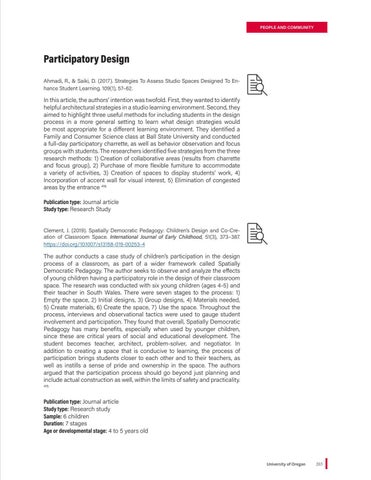PEOPLE AND COMMUNITY
Participatory Design Ahmadi, R., & Saiki, D. (2017). Strategies To Assess Studio Spaces Designed To Enhance Student Learning. 109(1), 57–62.
In this article, the authors’ intention was twofold. First, they wanted to identify helpful architectural strategies in a studio learning environment. Second, they aimed to highlight three useful methods for including students in the design process in a more general setting to learn what design strategies would be most appropriate for a different learning environment. They identified a Family and Consumer Science class at Ball State University and conducted a full-day participatory charrette, as well as behavior observation and focus groups with students. The researchers identified five strategies from the three research methods: 1) Creation of collaborative areas (results from charrette and focus group), 2) Purchase of more flexible furniture to accommodate a variety of activities, 3) Creation of spaces to display students’ work, 4) Incorporation of accent wall for visual interest, 5) Elimination of congested areas by the entrance 418. Publication type: Journal article Study type: Research Study Clement, J. (2019). Spatially Democratic Pedagogy: Children’s Design and Co-Creation of Classroom Space. International Journal of Early Childhood, 51(3), 373–387. https://doi.org/10.1007/s13158-019-00253-4
The author conducts a case study of children’s participation in the design process of a classroom, as part of a wider framework called Spatially Democratic Pedagogy. The author seeks to observe and analyze the effects of young children having a participatory role in the design of their classroom space. The research was conducted with six young children (ages 4-5) and their teacher in South Wales. There were seven stages to the process: 1) Empty the space, 2) Initial designs, 3) Group designs, 4) Materials needed, 5) Create materials, 6) Create the space, 7) Use the space. Throughout the process, interviews and observational tactics were used to gauge student involvement and participation. They found that overall, Spatially Democratic Pedagogy has many benefits, especially when used by younger children, since these are critical years of social and educational development. The student becomes teacher, architect, problem-solver, and negotiator. In addition to creating a space that is conducive to learning, the process of participation brings students closer to each other and to their teachers, as well as instills a sense of pride and ownership in the space. The authors argued that the participation process should go beyond just planning and include actual construction as well, within the limits of safety and practicality. 415.
Publication type: Journal article Study type: Research study Sample: 6 children Duration: 7 stages Age or developmental stage: 4 to 5 years old
University of Oregon
203

